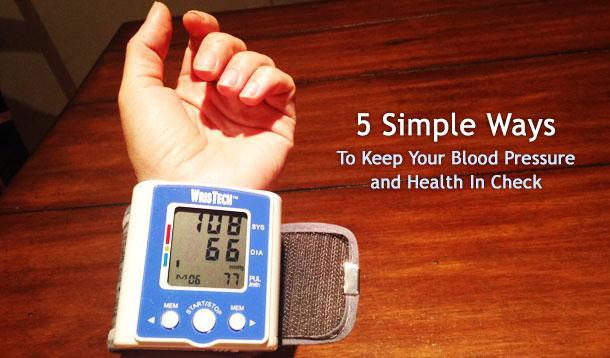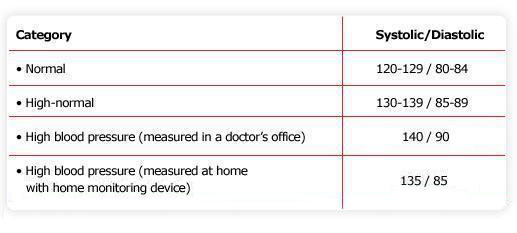
Even though I'm a Registered Dietitian, eat a healthy balanced diet (most of the time) and make physical activity part of my daily routine, I am not immune to developing health problems. Because high blood pressure—also known as hypertension—runs in my family (both of my parents have it), I am at an increased risk of developing it. If I continue to take good care of myself by eating well and staying active, I may be able prevent hypertension, but if my blood pressure eventually does creep up, I will do my best to keep it well controlled. But in order to stay on top of things, I need to maintain a healthy lifestyle and that includes knowing my numbers.
What's scary about hypertension is that it often goes undiagnosed—the symptoms are usually unrecognizable. Even so, over 5 million Canadian adults have high blood pressure, nearly 1.3 million of which are females ages 20-64. Considering the fact that hypertension is the number one risk factor for stroke, and can put you in danger of developing atherosclerosis (hardening of the arteries), heart disease, dementia and kidney disease (among other health problems), it's important to be pro-active and monitor your blood pressure regularly.
The truth is, regardless of your family history, gender or age, it's important to monitor your blood pressure regularly—even as a young mom.
Here are 5 ways you can keep your blood pressure (and health!) in check:
As a busy work-at-home mom of little ones, it's hard to remember to wash my hair, let alone keep track of my blood pressure. That is why I was thrilled to receive my very own Jobar Wristech Blood Pressure Monitor from Canada’s leading electronics-focused e-retailer Newegg at Home. Since receiving the monitor, it has made it much easier for me to keep track of my numbers.
What I love most about this monitor is that it has an adjustable strap that fits around my wrist like a watch (the wrist style eliminates uncomfortable pumping method you are used to), and I simply press a button and wait a few seconds to read my numbers on the large LCD screen. That's it!
I don't know about you, but I don't have time to make a pit stop at the public health clinic, my doctor's office, or the drug store to take my blood pressure once a day, or even once a month for that matter. That's why I love having my own blood pressure monitor—it's a quick and convenient way to stay on top of my blood pressure levels regularly. This monitor has the ability to store up to 60 readings so you can monitor and keep track of your health over time. If my numbers start to climb one day, I will recognize it and take the steps to control them right away.
Your blood pressure is measured with two numbers (e.g., 120/80 millimetres of mercury). The top number (e.g., 120) is what's known as your systolic blood pressure, which occurs when your heart contracts, and the bottom number (e.g., 80) is the diastolic blood pressure, which occurs when your heart relaxes and fills with blood. The higher your blood pressure numbers, and the longer they stay high, the more damage there is to your blood vessels.
Here is a great chart that I found on The Canadian Heart and Stroke website that outlines what is normal and what is not when it comes to blood pressure levels:

Canadians consume, on average, about 3400 mg of sodium (salt) per day—more than double what is needed. As adults, we only need between 1200-1500 mg of sodium per day, and no more than 2300 mg/day. This is the equivalent of 1 teaspoon of table salt. Too much sodium can lead to high blood pressure. Any form of salt: kosher salt, sea salt, gourmet salt, fleur de sel, and smoked salt all have the same amount of sodium as table salt—there really isn't a "healthier" option. But using the salt shaker usually isn't the biggest problem—it's processed foods. Foods such as crackers, pretzels, potato chips, dips, sauces, ready-to-eat meals, deli meats, and even breakfast cereals are full of sodium. Eating out at restaurants and fast food joints often also increases your sodium consumption by a long shot.
Try to cook from scratch whenever possible. Use whole food ingredients such as fresh or frozen fruits and vegetables, fresh meats and fish and meat alternatives (eggs, dried beans, lentils, nuts and seeds), whole grains, and low-fat dairy products. Adding flavour to your home-cooked dishes using lemon, garlic, ginger, fresh or dried herbs, spices and vinegar is a great way to go, and if you focus on real ingredients, adding a little bit of salt here and there for added flavour, is fine too. It's almost impossible to avoid packaged, processed foods all together, so when you're looking at nutrition facts, look for products that contains less than 200 mg of sodium per serving.
Make sure to eat plenty of fresh or frozen fruits and veggies every day, as they contain essential nutrients such as vitamins, minerals, fibre, and antioxidants that keep you healthy and decrease your risk of chronic disease. Try to aim for at least four colours (or more) per day, including at least one serving at each meal and snack that you eat. I try to include fruit at breakfast and at a mid-morning snack, and vegetables at lunch and dinner as well as my afternoon snack (if I have one).
I enjoy a good glass of wine as much (or more) as the next person, but I also recognize that too much alcohol doesn't only add extra empty calories, but also increases my risk of developing high blood pressure over time. Women should limit themselves to no more than one standard drink per day (about 4 oz of wine, 1 bottle of beer or 1.5 oz of spirits) and men should limit themselves to no more than two standard drinks per day.
When it comes to preventing hypertension and keeping your numbers within a healthy range, besides monitoring your blood pressure regularly and eating healthfully, moving your body is absolutely key.
I'm not a huge fan of the word "exercise" because I often find that it is translated into "torture," which it's not supposed to be. Instead, just start moving your body in an enjoyable way. If you like to dance, sign up for a dance class. If you enjoy swimming, join a masters swim team at your local pool. If you enjoy going to the gym, buy a gym pass that has childcare so that you can take your kids. Or if you love walking, recruit a friend who can walk with you and keep you accountable. Regardless of the activity (or activities), make sure you enjoy doing it and that you can see yourself sticking with it. Aim for at least 30 minutes per day.

This is proudly sponsored by our friends at Newegg.ca.
www.newegg.ca
Newegg.ca is the leading electronics-focused e-retailer in Canada.